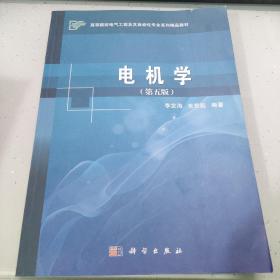
电机学(第五版)(英文版)
¥ 120 八五品
仅1件
江西南昌
认证卖家担保交易快速发货售后保障
作者[美]Stephen J. Chapman(斯蒂芬J.查普曼) 著
出版社电子工业出版社
出版时间2014-02
版次01
装帧平装
上书时间2023-08-05
- 最新上架
商品详情
- 品相描述:八五品
图书标准信息
- 作者 [美]Stephen J. Chapman(斯蒂芬J.查普曼) 著
- 出版社 电子工业出版社
- 出版时间 2014-02
- 版次 01
- ISBN 9787121224409
- 定价 78.00元
- 装帧 平装
- 开本 16开
- 纸张 胶版纸
- 页数 556页
- 正文语种 英语
- 丛书 电气工程、自动化专业规划教材
- 【内容简介】
- 本书是关于电机学的经典教材。全书内容涉及电机原理、变压器、交流电机、同步发电机、同步电动机、感应电动机、直流电机、直流电动机和发电机、单相及特种电动机等,附录内容包括三相电路、线圈节距及分布绕组、同步电机的凸极理论、常数及转换系数表。全书叙述清晰,图文并茂,例题、习题丰富,并结合MATLAB进行了大量的仿真分析。
- 【作者简介】
- 1975年获路易斯安那州立大学电气工程学士学位,1979年获佛罗里达中央大学电气工程硕士学位,曾就读于莱斯大学继续更高层次的研究生阶段学习。从1975年到1980年,他以高级职员身份就职于美国海军,在位于佛罗里达州奥兰多的美国海军核动力学院讲授电气工程。从1980年到1982年,他受雇于休斯敦大学,在技术学院运作电力系统项目。从1988到1991年,Chapman先生为休斯敦地壳开发公司的研究工程师,从事地震信号处理研究。他也受雇于休斯敦大学,继续兼职从事教学工作。Chapman先生目前是位于墨尔本的澳大利亚BAE系统的系统建模和运行分析管理者。Chapman先生是电气和电子工程师协会(以及其多个分会)的高级会员,也是澳大利亚工程师协会的会员。
- 【目录】
-
TABLE OF CONTENTS
Chapter 1 Introduction to Machinery Principles1
1.1Electrical Machines, Transformers, and Daily Life1
1.2A Note on Units and Notation2
1.3Rotational Motion, Newton’s Law, and Power Relationships3
1.4The Magnetic Field7
1.5Faraday’s Law―Induced Voltage from a Time-Changing Magnetic Field22
1.6Production of Induced Force on a Wire25
1.7Induced Voltage on a Conductor Moving in a Magnetic Field26
1.8The Linear DC Machine―A Simple Example27
1.9Real, Reactive, and Apparent Power in Single-phase AC Circuits36
1.10Summary41
Questions42
Problems42
References49
Chapter 2 Transformers50
2.1Why Transformers are Important to Modern Life51
2.2Types and Construction of Transformers52
2.3The Ideal Transformer53
2.4Theory of Operation of Real Single-Phase Transformers59
2.5The Equivalent Circuit of a Transformer67
2.6The Per-Unit System of Measurements74
2.7Transformer Voltage Regulation and Efficiency79
2.8Transformer Taps and Voltage Regulation86
2.9The Autotransformer87
2.10Three-Phase Transformers92
2.11Three-Phase Transformation Using Two Transformers100
2.12Transformer Ratings and Related Problems107
2.13Instrument Transformers113
2.14Summary114
Questions115
Problems116
References122
Chapter 3 Ac Machinery Fundamentals123
3.1A Simple Loop in a Uniform Magnetic Field124
3.2The Rotating Magnetic Field129
3.3Magnetomotive Force and Flux Distribution on AC Machines136
3.4Induced Voltage in AC Machines138
3.5Induced Torque in an AC Machine143
3.6Winding Insulation in an AC Machine145
3.7AC Machine Power Flows and Losses146
3.8Voltage Regulation and Speed Regulation148
3.9Summary149
Questions150
Problems150
References151
Chapter 4 Synchronous Generators152
4.1Synchronous Generator Construction153
4.2The Speed of Rotation of a Synchronous Generator157
4.3The Internal Generated Voltage of a Synchronous Generator157
4.4The Equivalent Circuit of a Synchronous Generator158
4.5The Phasor Diagram of a Synchronous Generator162
4.6Power and Torque in Synchronous Generators163
4.7Measuring Synchronous Generator Model Parameters166
4.8The Synchronous Generator Operating Alone170
4.9Parallel Operation of AC Generators179
4.10Synchronous Generator Transients193
4.11Synchronous Generator Ratings199
4.12Summary207
Questions207
Problems208
References215
Chapter 5 Synchronous Motors216
5.1Basic Principles of Motor Operation216
5.2Steady-State Synchronous Motor Operation220
5.3Starting Synchronous Motors231
5.4Synchronous Generators and Synchronous Motors237
5.5Synchronous Motor Ratings238
5.6Summary238
Questions239
Problems240
References245
Chapter 6 Induction Motors246
6.1Induction Motor Construction247
6.2Basic Induction Motor Concepts249
6.3The Equivalent Circuit of an Induction Motor253
6.4Power and Torque in Induction MotorS258
6.5Induction Motor Torque?Speed Characteristics264
6.6Variations in Induction Motor Torque?speed Characteristics278
6.7Trends in Induction Motor Design285
6.8Starting Induction Motors288
6.9Speed Control of Induction Motors293
6.10Solid-State Induction Motor Drives300
6.11Determining Circuit Model Parameters306
6.12The Induction Generator313
6.13induction motor ratings318
6.14Summary319
Questions320
Problems321
References326
Chapter 7 Dc Machinery Fundamentals328
7.1A Simple Rotating Loop between Curved Pole Faces328
7.2Commutation in a Simple Four-Loop DC Machine338
7.3Commutation and Armature Construction in Real DC Machines342
7.4Problems with Commutation in Real Machines351
7.5The Internal Generated Voltage and Induced Torque Equations of Real DC Machines361
7.6The Construction of DC Machines364
7.7Power Flow and Losses in DC Machines369
7.8Summary371
Questions372
Problems372
References376
Chapter 8 Dc Motors And Generators377
8.1Introduction to DC Motors378
8.2The Equivalent Circuit of a DC Motor379
8.3The Magnetization Curve of a DC Machine380
8.4Separately Excited and Shunt DC Motors381
8.5The Permanent-Magnet DC Motor399
8.6The Series DC Motor401
8.7The Compounded DC Motor406
8.8DC Motor Starters410
8.9The Ward-Leonard System and Solid-State Speed Controllers418
8.10DC Motor Efficiency Calculations425
8.11Introduction to DC Generators427
8.12The Separately Excited Generator428
8.13The Shunt DC Generator434
8.14The Series DC Generator438
8.15The Cumulatively Compounded DC Generator439
8.16The Differentially Compounded DC Generator444
8.17Summary446
Questions447
Problems447
References457
Chapter 9 Single-Phase and Special-Purpose Motors458
9.1The Universal Motor459
9.2Introduction to Single-Phase Induction Motors461
9.3Starting Single-Phase Induction Motors468
9.4Speed Control of Single-Phase Induction Motors475
9.5The Circuit Model of a Single-Phase Induction Motor476
9.6Other Types of Motors482
9.7Summary492
Questions493
Problems494
References495
Chapter A Three-Phase Circuits496
A.1Generation of Three-Phase Voltages and Currents496
A.2Voltages and Currents in a Three-Phase Circuit499
A.3Power Relationships in Three-Phase Circuits502
A.4Analysis of Balanced Three-Phase Systems505
A.5One-Line Diagrams511
A.6Using the Power Triangle511
Questions514
Problems514
Reference516
Chapter B Coil Pitch and Distributed Windings517
B.1The Effect of Coil Pitch on AC Machines517
B.2Distributed Windings in AC Machines525
B.3Summary532
Questions533
Problems533
References534
Chapter C Salient-Pole Theory of Synchronous Machines535
C.1Development of the Equivalent Circuit of a Salient-Pole Synchronous Generator536
C.2Torque and Power Equations of a Salient-Pole Machines540
Problems542
Chapter D Tables of Constants and Conversion Factors543
点击展开
点击收起
相关推荐
— 没有更多了 —



















以下为对购买帮助不大的评价